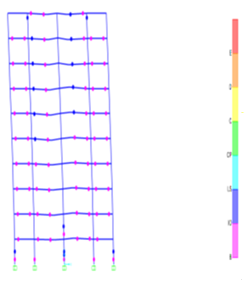Volume 2, Issue 4 (3-2019)
JCES 2019, 2(4): 0-0 |
Back to browse issues page
Download citation:
BibTeX | RIS | EndNote | Medlars | ProCite | Reference Manager | RefWorks
Send citation to:



BibTeX | RIS | EndNote | Medlars | ProCite | Reference Manager | RefWorks
Send citation to:
Hashemi S, Kiani zadegan R. Evaluation of Nonlinear Static Analysis Methods in Seismic Analysis of Concrete Frames with Shear Wall. JCES 2019; 2 (4)
URL: http://journals.lu.ac.ir/jces/article-1-47-en.html
URL: http://journals.lu.ac.ir/jces/article-1-47-en.html
Department of Civil Engineering, Yasuj University, Yasuj, Iran.
Abstract: (3540 Views)
In this paper, the reinforced concrete frames with concrete shear walls are studied from the perspective of the performance-based design method. The shear wall is modeled as an equivalent column with a rigid beam on its top and its hinges are assigned to the equivalent column depending on the moment or the shear governing the behavior of the wall. For this purpose, two-dimensional models of three reinforced concrete frames with concrete shear walls are created. Models with 5, 10 and 15 floors are created to represent the low-rise, mid-rise and high-rise buildings. The models are investigated using the traditional pushover analysis in SAP software. Moreover, adaptive analyses including force-based adaptive pushover (FAP) and displacement-based adaptive pushover (DAP) are conducted using SEISMO STRUCT software.
To investigate the validity, the results of the pushover analysis are compared with the results of nonlinear time history analysis. For nonlinear time history analysis, 7 far field earthquake records which were recorded from soils with shear wave velocities between 175 to 375 meters per second at a distance of approximately 20 km far from the epicenter of the earthquakes are selected.
The results of these investigations show that, for the high-rise and mid-rise buildings, the traditional pushover analysis results in more displacement and stresses in comparison to the nonlinear time history analysis. Also, the first mode pattern causes more drift than the other patterns. Adaptive analysis which was thought to be based on a stronger logic resulted in more inaccurate responses compared to the traditional pushover analysis. Significantly, DAP analysis failed to meet expectations. The results also show that structures with shear walls and matching the correct design based on linear analysis are resistant to phase shift and do not collapse. Another important result is that the buildings designed based on linear analysis of the Iran 2800 code perform well for non-linear analysis and practically never approach life safety, which is a performance level of Iran 2800 code. This study demonstrates that the frame-shear wall system is very effective in reducing the level of performance and is able to hold a building at low performance levels.
Keywords: Nonlinear static analysis, Reinforced concrete frame, Shear wall, Pushover analysis, Time history analysis
Review Paper: Research |
Subject:
Special
Received: 2019/03/3 | Accepted: 2019/05/4 | Published: 2019/03/15
Received: 2019/03/3 | Accepted: 2019/05/4 | Published: 2019/03/15
Send email to the article author
| Rights and permissions | |
 |
This work is licensed under a Creative Commons Attribution-NonCommercial 4.0 International License. |







